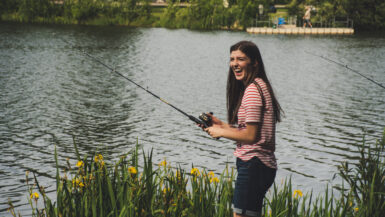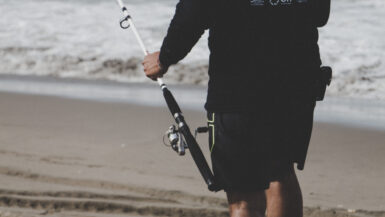Fishing is a beloved pastime for many and freshwater fishing is a popular choice for beginners and seasoned veterans alike. Choosing the right fishing reel is an important part of the process, as it will affect your success on the water. With so many different types available, it can be difficult to know which type is best for your needs. This article will provide an overview of the various types of freshwater fishing reels, their uses, and advice on how to pick the right one for your specific needs.
Factors to Consider When Choosing a Freshwater Fishing Reel
When it comes to freshwater fishing, there are a lot of choices when it comes to selecting a quality fishing reel. The available choices range from spinning reels to baitcasters, and each one offers a unique set of features and attributes that could make it well-suited for the specific type of freshwater fishing you’re interested in. Spinning reels are often the most popular choice for freshwater anglers since they are easy to use and versatile. Baitcasting reels, on the other hand, are heavier and intended for more experienced anglers.
Gear Ratio and Retrieve Speed
The gear ratio of a reel is indicative of the speed at which the spool turns in relation to the crank of the handle. The higher the ratio, the faster the reel is able to retrieve the line. When bass fishing with lures, a higher gear ratio is preferred since the increased speed can help keep the lure in the strike zone for a longer period of time. If the goal is to make long-range casts, then a lower gear ratio is recommended since it allows for a slower, more powerful retrieve.
Braking System
The braking system of a fishing reel is an important element to consider when looking for the right freshwater fishing reel. This device is used to control the cast and also helps to reduce backlashes. Braking systems are usually composed of either magnetic or centrifugal brakes. Magnetic brakes use an adjustable magnet to control the speed of the spool while centrifugal brakes use a series of small pins to slow the speed.
Line Capacity
Another critical aspect to consider when selecting a freshwater fishing reel is the line capacity. This refers to the amount of line that a reel can hold and is typically expressed in terms of the pounds test rating of the line. Larger reels are generally better suited for heavier lines, while smaller reels can typically hold lighter lines.
Construction and Durability
The construction and durability of a fishing reel are also essential when making a decision. High-end reels are typically made from aluminum or other corrosion-resistant materials that are built to last. Additionally, these reels will typically feature high-quality components like bearings, gears and other components that are designed for smooth operation and long-term reliability.
Price
Finally, the price of the reel should be taken into account. In most cases, the more expensive models will have better construction, more advanced features and greater reliability. That being said, there are some quality reels available at lower prices, so it is important to do your research and compare multiple models before making a purchase.
Overall, there are a lot of factors to consider when selecting a freshwater fishing reel. Understanding the different types of reels, the gear ratio, braking system, line capacity, construction and durability, as well as the overall price tag, will help ensure that you get the right reel for your specific needs.
Types of Reels Used for Freshwater Fishing
Spinning reels are the most popular choice for freshwater fishing. They are often used for most species of fish and come in a wide variety of sizes to fit the size of your catch. Spinning reels are easy to use and are relatively lightweight and offer many advantages for fishing in freshwater. Spinning reels have a drag system, which helps to control the line as the fish is reeled in. They also come with a variety of line weights and sizes, making them suitable for a range of species.
Baitcasting Reels for Freshwater Fishing
Baitcasting reels are a good option for experienced anglers who are targeting larger species in freshwater. These reels are designed to be able to handle heavier lines and lures, providing more control when reeling in heavy freshwater fish like bass and pike. The main advantage of baitcasting reels is that they allow for increased accuracy and distance when casting. Although they can be trickier to use, they are a great choice for anglers targeting larger species.
Fly Reels for Freshwater Fishing
Fly reels are a specialized type of reel that are used for fly fishing. Fly reels are designed for fishing with a very light line and often feature a drag system, which allows for greater control when casting and retrieving lures. The drag system also helps to reduce wear on the line when retrieving large and heavy fish. Fly reels are lightweight and designed with features that can help you to enjoy and master a technical form of fishing.
Trolling Reels for Freshwater Fishing
Trolling reels are a great choice for anglers looking to target larger freshwater fish such as muskie and northern pike. They are specifically designed for trolling, which involves using a line to drag a lure or bait behind a slowly moving boat. Trolling reels come with a drag system and special line weights that are better suited for this type of fishing. They also feature larger handles for increased leverage when winding in a catch.
Benefits of Freshwater Fishing
Freshwater fishing can be one of the most rewarding and enjoyable forms of angling. Not only is it a great way to relax and connect with nature, it can also be a great way to hone your skills as an angler. Whether you are looking to target small species with a spinning reel or hunt down bigger fish with a baitcasting reel, there are a wide range of options available to suit your needs. With the right freshwater fishing gear, you can enjoy a successful day on the water.
Value vs. Price
When it comes to your choice of a fishing reel for freshwater fishing, it’s important to remember that not all reels are created equal. It’s necessary to conduct detailed research to make sure that you’re purchasing a reel that fits your needs and preferences. A few factors to consider in your search include size of reel, features, price, and value.
Size of Reel
Size should be a key consideration when selecting a reel. Spinning reels are typically smaller, which makes them perfect for light tackle fishing. If you plan on using larger lures and heavier lines, then a casting reel will be a better option.
Features
The features of a fishing reel should also be evaluated prior to purchasing. This includes spool capacity, drag system, ball bearings, and gear ratio. Each of these specs can be found in the product description and can help you determine which reel is the best for your needs. Features such as anti-reverse and adjustable drag systems can also be beneficial depending on type of fishing.
Price
Price should also be taken into consideration when purchasing a fishing reel. There are a wide range of prices for different models and brands, so it is essential to find one that suits your budget and fits your needs. Generally, higher quality reels will have a higher price point, so it is important to assess whether the price is worth the features and durability of the reel.
Value
Value is another important factor when selecting the correct fishing reel. The value of a reel is the combination of features and price – the features of the reel in relation to the cost of the reel. Generally, higher quality reels with more features will have a higher value, but also a higher price. It is important to make sure that the features are worth the associated price, and that the value of the reel is worth the cost.
By researching and considering these four factors – size of reel, features, price, and value – you can be confident that the reel you select for freshwater fishing will suit your needs and be the perfect choice for a successful fishing outing.
Different Retrieval Ratios
When selecting a fishing reel for freshwater fishing, it is important to understand the concept of retrieval ratios. A retrieval ratio is a measure of how many turns of the handle it takes to make a single turn of the spool. A reel with a 4.9:1 ratio means that the spool rotates 4.9 times for every one turn of the handle.
Benefits of Different Retrieval Ratios
Retrieval ratios can vary from 1:1 to up to 6:1. A reel with a higher retrieval ratio allows for easier and faster retrieval of line, but requires more effort to bring in a large fish. A lower retrieval ratio, on the other hand, will make it more difficult to retrieve line quickly but is more suitable for reeling in large catches.
Using Retrieval Ratios to Choose a Fishing Reel
When selecting the right fishing reel for freshwater, the retrieval ratio must be considered. Spinners and light tackle reels, such as ultralight spinners, should be matched with a high retrieval ratio, allowing for easier and faster line retrieval. On the other hand, when choosing a reel for heavier baits such as crankbaits, crankbaits or jigs, a lower retrieval ratio is beneficial, as it provides more power to land larger catches.
Factors to Consider When Selecting a Fishing Reel
Retrieval ratios are just one of the factors to consider when selecting the right fishing reel for freshwater fishing. Other important factors include the reel’s gear ratio, the line capacity, and the amount of drag it provides. It is also important to consider the type of fish and the type of lures or baits being used. By understanding the different retrieval ratios and considering the other important factors, anglers can easily find the right fishing reel for their needs.
Tips for Maintaining a Fishing Reel
Choosing the right fishing reel for freshwater fishing is essential to ensuring that you have a successful outing. Before you make a purchase, take the time to consider the type of fish that you typically target, the type of fishing you do, and the quality of the reel itself. If you take all these factors into account, then you can be sure that you are buying a reel that gives you the best chance of success.
Learn How to Use a Fishing Reel
Before you begin using your new fishing reel, it is important to learn how to use it properly. This includes understanding the mechanics of the reel, as well as how it works in conjunction with your fishing rod. Additionally, you need to understand the basics of setting the drag and any other settings on the reel. Learning how to use a fishing reel properly will ensure that you get the best performance from it.
Maintain Your Fishing Reel
Once you have chosen and learned how to use your fishing reel, it is important to ensure that you maintain it properly. Proper maintenance will ensure that the reel continues to perform at its optimum level for a long period of time. This includes regularly cleaning the reel, lubricating the moving parts, and checking for signs of wear and tear. Additionally, you should store your reel in a dry place when it is not in use to ensure that it stays in good condition.
Keep Your Fishing Reel Organized
Organizing your fishing reel will help you maintain it properly. Store all the parts in a tackle box that is labeled clearly so you can find them easily when you are prepping for a fishing outing. Additionally, it is important to maintain the line on your reel by regularly checking it for signs of wear and tear, as well as cleaning it and removing any knots or tangles.
Inspect Your Fishing Reel Regularly
It is important to inspect your fishing reel regularly to ensure that it is in good working condition. Check for any signs of damage or wear, as well as any looseness in the handle or any parts of the reel. Additionally, ensure that the line is taut and free of knots or tangles. If any of these issues are present, then it is best to repair or replace the reel as soon as possible.
Choose the Right Line for Your Fishing Reel
The type of line that you use on your fishing reel can have a huge impact on its performance. Therefore, it is important to choose a line that is appropriate for the type of fishing that you do. This means considering the type of fish that you typically target, as well as the weight and power of your rod. Additionally, you need to consider the type of water that you typically fish in and the weather conditions. All of these factors will help you determine the right line for your reel.
Knowing What to Look For
When selecting a fishing reel for freshwater fishing, the most important factors to consider are the type of fish, the size of the reel, and the line capacity of the reel. Before settling on a specific reel, it’s important to research the type of fish you will be targeting, as well as the strength of the hook, size of the line, and the length of your rod. Reels for freshwater fishing come in several sizes, from small spinning reels for light-duty applications, to larger bait-casting reels for heavier fish. Knowing how much line capacity you need will also be a factor in choosing the right reel—larger reels can hold more line, while smaller ones can cast lighter lures farther. Additionally, comparing prices and features of different models may help you to find the perfect fishing reel for your needs. With the right information and an attention to detail, you can make an educated decision when selecting the right reel for your freshwater fishing.





Leave a reply